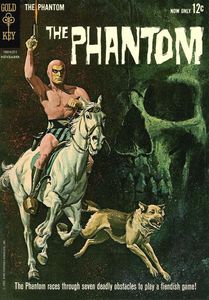 Who is the first superhero? As a comic BOOK guy, I would have always gone with Superman. He had the costume, the powers, and eventually, the catch phrase. Of course, Superman busted onto the scene in Action Comics 1, 1939. But Superman wasn't the first character to wear a costume, fight evil, and star in a visual storytelling format. That honor appears to go to Lee Falk's Phantom. His comic STRIP debuted in 1936, three years before the "strange visitor from another planet". The "Ghost who walks" certainly deserves some love--he fought evil AND had a costume. However, for the sake of this series of articles, I prefer to go back a little farther to another medium. I assert the first superhero is Doc Savage.
Who is the first superhero? As a comic BOOK guy, I would have always gone with Superman. He had the costume, the powers, and eventually, the catch phrase. Of course, Superman busted onto the scene in Action Comics 1, 1939. But Superman wasn't the first character to wear a costume, fight evil, and star in a visual storytelling format. That honor appears to go to Lee Falk's Phantom. His comic STRIP debuted in 1936, three years before the "strange visitor from another planet". The "Ghost who walks" certainly deserves some love--he fought evil AND had a costume. However, for the sake of this series of articles, I prefer to go back a little farther to another medium. I assert the first superhero is Doc Savage.
Phantom 1 from 1962 (Gold Key)
Can Doc Savage Claim to be the First Superhero?
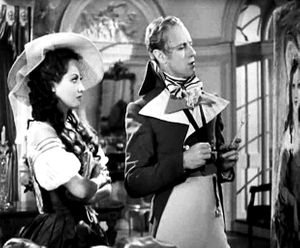 Many probably realize Doc Savage did not originate as a comic book OR comic strip character. His lineage traces to those short novels printed on low quality paper called "the pulps". So, since I'm changing the media once again, could D'Artagnan from the Three Musketeers or the Scarlet Pimpernel qualify as the first superhero?
Many probably realize Doc Savage did not originate as a comic book OR comic strip character. His lineage traces to those short novels printed on low quality paper called "the pulps". So, since I'm changing the media once again, could D'Artagnan from the Three Musketeers or the Scarlet Pimpernel qualify as the first superhero?
Alexandre Dumas created D'Artagnan. His heroics as a swashbuckling fencer won him a place among the Three Musketeers. The Dumas book was published in 1844. D'Artagnan's derring-do could be compared to any modern superhero.
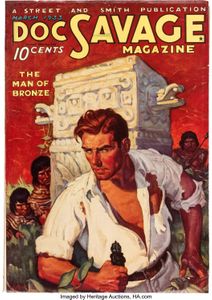 Now, let's consider the Scarlet Pimpernel. Many modern superheroes conceal their secret identities, not unlike the Baroness Orczy's hero the Scarlet Pimpernel. In her 1905 play, Sir Percy acted the wealthy playboy by day concealing his skills as a master of disguise and escape after dark. Leslie Howard and Merle Oberon starred in the 1934 film.
Now, let's consider the Scarlet Pimpernel. Many modern superheroes conceal their secret identities, not unlike the Baroness Orczy's hero the Scarlet Pimpernel. In her 1905 play, Sir Percy acted the wealthy playboy by day concealing his skills as a master of disguise and escape after dark. Leslie Howard and Merle Oberon starred in the 1934 film.
Besides these heroes, surely Sherlock Holmes and Tarzan are nothing short of superheroes as well.
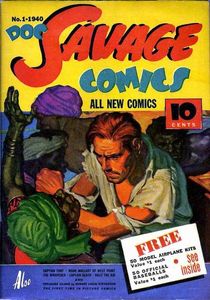 Doc Savage Magazine 1933 - 1st appearance of Doc Savage sold for $22,800 through Heritage Auctions in December 2020.
Doc Savage Magazine 1933 - 1st appearance of Doc Savage sold for $22,800 through Heritage Auctions in December 2020.
Doc Savage Comics 1 - 1st appearance in comics, only 25 CGC graded copies in all grades.
Man of Bronze Origins
Clearly, my thesis that Doc Savage is the first superhero is about as put-together as one of Doc's oft-torn shirts. After all, Doc Savage as the brainchild of Street and Smith honchos Henry W. Ralston and John L. Nanovic wasn't published until 1933. Nonetheless, the character brought to life by Lester Dent and others under the pseudonym Kenneth Robeson enjoys an enduring place in my heart. Credited with inspiring facets of the Superman mythos, Doc Savage is no slouch in the battle against evil, either. So, I will declare his merits as "the first superhero" and reflect on some amazing Man of Bronze collectibles along the way.
Collectibles Worth their Weight in Flake Gold
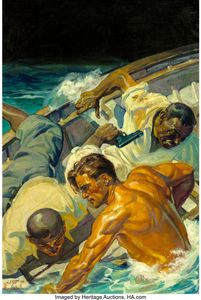 Doctor Clark Savage, Jr can be identified by his bronze skin, giant frame, and flake gold eyes. And you may need some of each if you plan to buy an original pulp cover painting by famed artist Walter Baumhofer. Cover art from Red Snow (1935) measured roughly 30 inches by 20 inches and sold for $84K in 2019. Baumhofer reportedly painted about 550 pulp magazine covers including many early Doc Savage works.
Doctor Clark Savage, Jr can be identified by his bronze skin, giant frame, and flake gold eyes. And you may need some of each if you plan to buy an original pulp cover painting by famed artist Walter Baumhofer. Cover art from Red Snow (1935) measured roughly 30 inches by 20 inches and sold for $84K in 2019. Baumhofer reportedly painted about 550 pulp magazine covers including many early Doc Savage works.
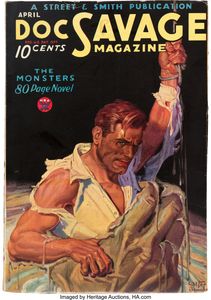 Doc Savage art, pulps, and comics from the 1930s and early 1940s typically can't be found in the dollar bins of your LCS. However, a high quality collection recently sold through HA.com. As an example, a FN+ copy of Doc Savage The Monsters fetched $1,260. The Bookery's Guide to Pulps list value is $900 in VF condition. Because of the poor quality materials used in creating pulps and wartime recycling efforts, relatively few high grade copies exist.
Doc Savage art, pulps, and comics from the 1930s and early 1940s typically can't be found in the dollar bins of your LCS. However, a high quality collection recently sold through HA.com. As an example, a FN+ copy of Doc Savage The Monsters fetched $1,260. The Bookery's Guide to Pulps list value is $900 in VF condition. Because of the poor quality materials used in creating pulps and wartime recycling efforts, relatively few high grade copies exist.
With a Little Help from His Friends
Except in my own mind, no one is convinced that Doc Savage is the first superhero. I'll close by citing some of his super heroic qualities. First, he is a mental and physical workout warrior spending two hours a day on exercises to hone his body and mind. Next, he is a genius and expert in almost every field, including the medical profession. Doc is a team player, as well. Like Superman, he has a team of competent heroes he associates with, even though he doesn't really need their help. And finally, his tattered shirts are a signature look, practically a costume.
With little media presence, Doc needs some help to stay in the frontal lobe of today's superhero connoisseurs. For that reason, I'll write some additional Man of Bronze articles, each focusing on a different generation of Doc's exploits. Certainly, the Doc collectibles of the period will be highlighted
For those who like old heroes, check out my article on Dick Tracy.











